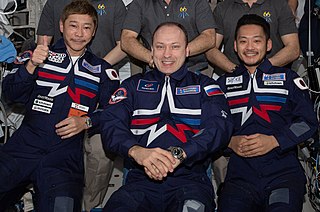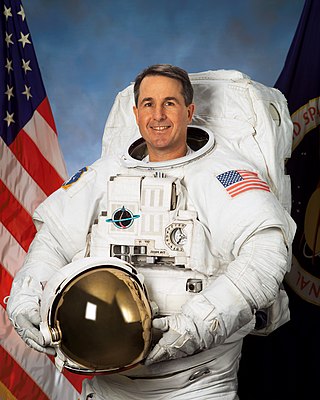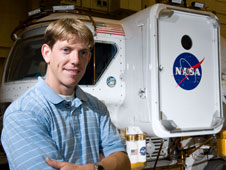
Space tourism is human space travel for recreational purposes. There are several different types of space tourism, including orbital, suborbital and lunar space tourism.

A lander is a spacecraft that descends towards, then comes to rest on the surface of an astronomical body other than Earth. In contrast to an impact probe, which makes a hard landing that damages or destroys the probe upon reaching the surface, a lander makes a soft landing after which the probe remains functional.

The Canadian Space Agency is the national space agency of Canada, established in 1990 by the Canadian Space Agency Act.

Stephen Kern Robinson is an American former NASA astronaut.

Gregory Errol Chamitoff is a Canadian-born American engineer and former NASA astronaut. He has been to space twice, spending 6 months aboard the ISS across Expedition 17 and 18 in 2008, and another 15 days as part of STS-134 in 2011. STS-134 was the last of Space Shuttle Endeavour which delivered the Alpha Magnetic Spectrometer and completed the US Orbital Segment.

Dava J. Newman is an American aerospace engineer. She is the director of the MIT Media Lab and a former deputy administrator of NASA. Newman is the Apollo Program Professor of Aeronautics and Astronautics and Engineering Systems at the Massachusetts Institute of Technology. She has been a faculty member in the department of Aeronautics and Astronautics and MIT's School of Engineering since 1993.

The idea of sending humans to Mars has been the subject of aerospace engineering and scientific studies since the late 1940s as part of the broader exploration of Mars. Long-term proposals have included sending settlers and terraforming the planet. Proposals for human missions to Mars have come from agencies such as NASA, CNSA, the European Space Agency, Boeing, and SpaceX. As of 2023, only robotic landers and rovers have been on Mars. The farthest humans have been beyond Earth is the Moon, under the Apollo program.

Jeanette Jo Epps is an American aerospace engineer and NASA astronaut. Epps received both her M. S. and Ph.D. degrees in aerospace engineering from the University of Maryland, where she was part of the rotor-craft research group and was a NASA GSRP Fellow. She was chosen for the 20th class of NASA astronauts in 2009, graduating in 2011. Epps currently serves as a member of the ISS Operations Branch and has completed analog astronaut missions, including NEEMO 18 and CAVES 19. She is the second woman and first African-American woman to have participated in CAVES. She has been selected to fly to the ISS in early 2024 as part of the SpaceX Crew-8 crew.

Robert David Braun is an American aerospace engineer and academic. He has served as the dean of the College of Engineering and Applied Science at the University of Colorado Boulder, the David and Andrew Lewis Professor of Space Technology at the Georgia Institute of Technology, and the NASA Chief Technologist. Currently, Dr. Braun is the Space Sector Head at the Johns Hopkins University Applied Physics Laboratory (APL).

Dr. Andrew Frank Jorgensen Abercromby is a scientist and biomedical engineer who designs and tests spacesuit systems and exercise countermeasures for future exploration of the Solar System. He is employed by NASA as Lead of the Human Physiology, Performance, Protection & Operations (H-3PO) Laboratory at Johnson Space Center in Houston, Texas. As an aquanaut, Abercromby served as a member of the NASA Extreme Environment Mission Operations 14 crew. Abercromby has more than fifteen years of experience working in the Human Health and Performance (HH&P) and Engineering Directorates at the Johnson Space Center. He is married with two daughters.

Steven Patrick Chappell is an American aerospace engineer. He is a Technical Lead & Research Specialist for Wyle Integrated Science & Engineering at NASA's Johnson Space Center (JSC) in Houston, Texas. He is helping to define and execute the research needed to optimize human performance in next-generation spacesuits and extra-vehicular activity (EVA) systems. Chappell served as an aquanaut on the NASA Extreme Environment Mission Operations 14 crew.

The Deep Space Habitat (DSH) is a series of concepts explored between 2012 and 2018 by NASA for methods to support crewed exploration missions to the Moon, asteroids, and eventually Mars. Some of these concepts were eventually used in the Lunar Gateway program.
Mars One was a small private Dutch organization that received money from investors by claiming it would use it to land the first humans on Mars and leave them there to establish a permanent human colony. From its announcement in 2012 to its bankruptcy in early 2019, it is estimated to have received tens of millions of dollars. The organization was not an aerospace company and did not manufacture hardware.

The Martian Moons eXploration (MMX) is a robotic space probe set for launch in 2024 to bring back the first samples from Mars' largest moon Phobos. Developed by the Japanese Aerospace Exploration Agency (JAXA) and announced on 9 June 2015, MMX will land and collect samples from Phobos once or twice, along with conducting Deimos flyby observations and monitoring Mars's climate.

Farah Alibay is a Canadian systems engineer at the NASA Jet Propulsion Laboratory who has worked on the InSight, Mars Cube One, and Mars 2020 missions.

Tiera Fletcher is an American engineer who graduated from MIT in 2017 and works for Boeing. She is one of the designers and structural analysts building the Space Launch System for NASA which is set to send people to Mars.

Moriba Kemessia Jah is an American space scientist and aerospace engineer who describes himself as a "space environmentalist", specializing in orbit determination and prediction, especially as related to space situational awareness and space traffic monitoring. He is currently an associate professor of Aerospace Engineering and Engineering Mechanics at the University of Texas at Austin. Jah previously worked as a spacecraft navigator at the NASA Jet Propulsion Laboratory, where he was a navigator for the Mars Global Surveyor, Mars Odyssey, Mars Express, Mars Exploration Rover, and his last mission was the Mars Reconnaissance Orbiter. He is a Fellow of the American Astronautical Society, the Air Force Research Laboratory, the International Association for the Advancement of Space Safety and, the Royal Astronomical Society. Jah was also selected into the 10th anniversary class of TED Fellows and was named a MacArthur Fellow in 2022. He also was selected into the AIAA class of Fellows and Honorary Fellows in the year of the 50th Anniversary of Apollo 11. The AIAA "confers the distinction of Fellow upon individuals in recognition of their notable and valuable contributions to the arts, sciences or technology of aeronautics and astronautics."
Kavya K. Manyapu is an Indian–American aerospace engineer and scientist. She currently works at NASA in the Extravehicular Branch for Lunar Exploration missions within the Flight Operations Directorate at JSC. She was part of the Boeing team for nearly 10 years that developed the CST-100 Starliner spacecraft. She developed a fabric for self-cleaning space suits that uses carbon nanotubes to repel dust for use in future lunar and Mars missions.
















